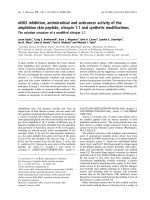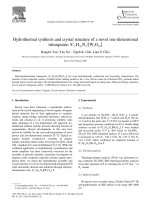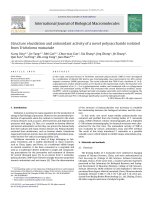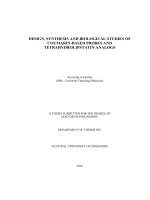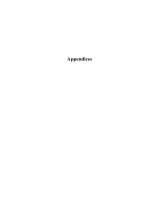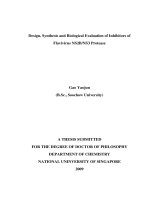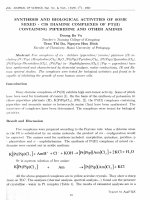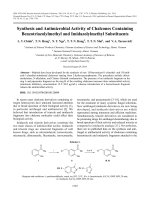Design, synthesis and anticancer activity of some novel thioureido-benzenesulfonamides incorporated biologically active moieties
Bạn đang xem bản rút gọn của tài liệu. Xem và tải ngay bản đầy đủ của tài liệu tại đây (1.11 MB, 13 trang )
Ghorab et al. Chemistry Central Journal (2016) 10:19
DOI 10.1186/s13065-016-0161-4
RESEARCH ARTICLE
Open Access
Design, synthesis and anticancer activity
of some novel thioureido‑benzenesulfonamides
incorporated biologically active moieties
Mostafa M. Ghorab1,2*, Mansour S. Alsaid1, Mohamed S. Al‑Dosary1, Yassin M. Nissan3 and Sabry M. Attia4
Abstract
Background: Many thiourea derivatives have exhibited biological activities including anticancer activity through
several mechanisms. On the other hand, benzenesulfonamide derivatives have proven to be good anticancer agents.
Hybrids of both moieties could be further developed to explore their biological activity as anticancer.
Results: Novel series of thioureidobenzenesulfonamides incorporating miscellaneous biologically active moieties
3–17 were designed and synthesized utilizing 4-isothiocyanatobenzenesulfonamide 2 as strategic starting material.
The structures of the newly synthesized compounds were established on the basis of elemental analyses, IR, 1H-NMR,
13
C-NMR and mass spectral data. All the newly synthesized compounds were evaluated for their in vitro anticancer
activity against various cancer cell lines. Most of the synthesized compounds showed good activity, especially com‑
pounds 3, 6, 8, 9, 10, 15 and 16 which exhibited good activity higher than or comparable to the reference drugs,
DCF and Doxorubicin, except breast cancer line. As a trial to suggest the mechanism of action of the active com‑
pounds, molecular docking on the active site of mitogen kinase enzyme (MK-2) was performed and good results were
obtained especially for compound 3.
Conclusion: Compounds 3, 6, 8, 9, 10, 15 and 16 may represent good candidates for further biological investiga‑
tions as anticancer agents. Their cytotoxic activity could be due to their action as MK-2 enzyme inhibitors.
Keywords: Synthesis, Sulfonamides, Thioureido, Anticancer activities
Background
Various types of cancer are now considered as the second cause of death after cardiovascular disorders [1].
The inability of the present anticancer chemotherapeutic
agents to discriminate between normal cells and cancer
cells comprises the biggest challenge for successful cancer treatment [2]. Serious side effects of anticancer chemotherapeutic agents limit their usage and in many cases
surgery or radiotherapy replace them [3]. The continuous
seek for safer and more effective anticancer agents is still
a major goal for medicinal chemists.
Thiourea is a versatile synthetic block for the synthesis of a wide variety of new organic compounds with
*Correspondence:
1
Department of Pharmacognosy, College of Pharmacy, King Saud
University, P.O. Box 2457, Riyadh 11451, Saudi Arabia
Full list of author information is available at the end of the article
biological activity including antimicrobial, antifungal,
antidiabetic, antimalarial, anti HIV and CNS active drugs
[4–11]. Many of aryl thiourea derivatives have applications in medicine, industry and agriculture [12–15].
Thiourea was incorporated in many tyrosine kinase
inhibitors because of its ability to form powerful hydrogen bonds in the ATP binding pocket of the enzymes
[16]. The thiourea derivative YH345 A has shown strong
protein farnesyl transferase inhibition activity [17]. Also
several heterocyclic thiourea derivatives have shown
strong DNA topoisomerase inhibitory activity [18].
On the other hand, sulfonamide derivatives posses a
wide range of biological activity including antibacterial,
anticonvulsant, anti-inflammatory and anticancer activity [19–22]. The mechanism of anticancer activity may
involve a wide range of different mechanisms, such as
cell cycle arrest in the G1 phase [23] and inhibition of
© 2016 Ghorab et al. This article is distributed under the terms of the Creative Commons Attribution 4.0 International License
( which permits unrestricted use, distribution, and reproduction in any medium,
provided you give appropriate credit to the original author(s) and the source, provide a link to the Creative Commons license,
and indicate if changes were made. The Creative Commons Public Domain Dedication waiver ( />publicdomain/zero/1.0/) applies to the data made available in this article, unless otherwise stated.
Ghorab et al. Chemistry Central Journal (2016) 10:19
carbonic anhydrase [24], histone deacetylases (HDACs)
[25], methionine amino peptidases (MetAPs) [26], matrix
metalloproteinase (MMPs) [27], nicotinamide adenine
dinucleotide (NADH) oxidase [28], cyclin-dependentkinase (CDK) [29], binding to β-Tubulin, and disruption
of microtubule assembly [30]. Indisulam (E7070) B is an
example of an anticancer agent that contains sulfonamide
moiety [31].
Based on the previous facts and as a continuation of
our previous work in the seek of novel anticancer agents
[32–38], we herein report the synthesis and biological
evaluation of new sulfonamide thiourea derivatives 3–17
presented by general structure C as hybrid molecules of
benzensulfonamide and thiourea moieties as anticancer
agents. Molecular docking of the active newly synthesized compounds was performed on the active site of
mitogen activated kinase enzyme (MK-2) in a trial to suggest a mechanism of action for their cytotoxic activity.
Results and discussion
Chemistry
The aim of this work was to design and synthesize a new
series of thioureidobenzenesulfonamide derivatives having miscellaneous biologically active moieties to evaluate
their anticancer activity. Thus, interaction of 4-isothiocyanatobenzenesulfonamide 2 with several amines in dry
N,N-dimethylformamide containing triethlyamine as catalyst afforded the corresponding thioureidobenzenesulfonamude derivatives 3–17 (Schemes 1 and 2). The
structures of the obtained compounds were established
on the basis of elemental analyses and spectral data.IR
spectra of compounds 3–17 showed the absence of
N=C=S group and presence absorption bands for (NH),
(CH arom.), (CH aliph.), (C=S) and (SO2). 1H-NMR
spectra of compounds 3–17 exhibited a singlets at 7.8–
13.8 ppm assigned to 2NH groups of thiourea which were
exchanged upon duetration.IR spectrum of compound 3
showed the characteristic bands at 3312, 3214 cm−1
(NH), 3099 cm−1 (CH arom.), 2202 cm−1 (C≡N),
1655 cm−1 (C=O), 1387, 1157 cm−1 (SO2), 1250 cm−1
(C=S). 1H-NMR spectrum of compound 3 exhibited a
triplet signal at 0.8 ppm due to CH3, a multiplet at 1.2–
1.4 ppm due to 5CH2, a mutiplet at 3.3 ppm due to
NHCH2 and singlets at 9.3 and 10.4 ppm assigned to
2NH groups which were exchangeable with D2O. Mass
spectrum of compound 3 revealed a molecular ion peak
m/z at of 329 (M+) (14.41) with a base peak appeared at
155 (100). 13C-NMR spectrum of compound 3 exhibited
signals at 177.4 ppm assigned to (C=S). IR spectrum of
compound 4 showed the characteristic bands at
3363 cm−1 (OH), 3280, 3143 cm−1 (NH, NH2), 3090 cm−1
(CH arom.), 1393, 1182 cm−1 (SO2), 1274 cm−1 (C=S).
1
H-NMR spectrum of compound 4 exhibited signals at
Page 2 of 13
10.2, 11.4 attributed to 2NH groups and 13.1 ppm
assigned to OH group which exchangeable with D2O.
Mass spectrum of compound 4 revealed a molecular ion
peak m/z at of 323 (M+) (9.03) with a base peak appeared
at 91 (100). 13C-NMR spectrum of compound 4 showed
signals at 180.1 ppm assigned to (C=S).IR spectrum of
compound 5 revealed the characteristic bands at 3317,
3254, 3173 cm−1 (NH, NH2), 3100 cm−1 (CH arom.),
2963, 2938, 2829 cm−1 (CH aliph.), 1363, 1156 cm−1
(SO2), 1259 cm−1 (C=S). 1H-NMR spectrum of compound 5 exhibited singlet at 3.9 ppm attributed to
3OCH3 groups and singlet at 9.8 ppm assigned to 2NH
groups, which exchangeable with D2O. Mass spectrum of
compound 5 revealed a molecular ion peak m/z at of 367
(M+) (17.8) with a base peak appeared at 76 (100). 13CNMR spectrum of compound 5 exhibited signals at
179.3 ppm assigned to (C=S).IR spectrum of compound
6 showed the characteristic bands at 3353, 3243,
3171 cm−1 (NH, NH2), 3009 cm−1 (CH arom.), 1340,
1161 cm−1 (SO2), 1290 cm−1 (C=S). 1H-NMR spectrum
of compound 6 revealed singlet at 10.3 ppm assigned to
2NH groups, which exchangeable with D2O. Mass spectrum of compound 6 exhibited a molecular ion peak m/z
at of 366 (M+) (15.8) with a base peak appeared at 133
(100). 13C-NMR spectrum of compound 6 exhibited singlet at 180.1 ppm assigned to (C=S). IR spectrum of
compound 7 exhibited the characteristic bands at 3325,
3241 cm−1 (NH, NH2), 3100 cm−1 (CH arom.), 1331,
1156 cm−1 (SO2), 1241 cm−1 (C=S). 1H-NMR spectrum
of compound 7 showed singlet at 9.5 ppm assigned to
2NH groups, which exchangeable with D2O. Mass spectrum of compound 7 revealed a molecular ion peak m/z
at of 351 (M+) (34.64) with a base peak appeared at 93
(100). 13C-NMR spectrum of compound 7 showed signal
at 180.6 ppm assigned to (C=S). IR spectrum of compound 8 exhibited the characteristic bands at 3384, 3348,
3206 cm−1 (NH, NH2), 3003 cm−1 (CH arom.), 1377,
1185 cm−1 (SO2), 1294 cm−1 (C=S). 1H-NMR spectrum
of compound 8 showed singlet at 7.8 ppm attributed to
2NH groups, which exchangeable with D2O. Mass spectrum of compound 8 exhibited a molecular ion peak m/z
at of 365 (M+) (18.42) with a base peak appeared at 135
(100). 13C-NMR spectrum of compound 8 showed signal
at 161.1 ppm attributed to (C=S). IR spectrum of compound 9 revealed the characteristic bands at 3434,
3354 cm−1 (NH, NH2), 3100 cm−1 (CH arom.), 2997,
2906, 2851 (CH aliph.), 1396, 1186 (SO2), 1282 (C=S).
1
H-NMR spectrum of compound 9 exhibited multiplet at
1.9 ppm due to 6CH2, a multiplet at 2.2–2.4 due to 3CH
and singlet at 11.4 ppm due to 2NH groups, which
exchangeable with D2O. Mass spectrum of compound 9
exhibited a molecular ion peak m/z at of 366 (M+) (9.32)
with a base peak appeared at 154 (100). 13C-NMR
Ghorab et al. Chemistry Central Journal (2016) 10:19
Page 3 of 13
S
NH2
NH 2
NH
H 2NO2S
NH
OH
(3)
S
SO2NH2
HO
(1)
NH2
NH
H2 NO2S
NH
(4)
CSCl2
O
O
NH2
N
C
S
S
NH
DMF
O
O
H2NO2S
TEA
SO2NH2
(2)
NH
(5)
O2N
NH2
S
O2N
NH
H 2NO2S
NH 2
NH
O
(6)
O
S
O
NH
O
H 2NO2 S
NH
NH2
O
(7)
O
S
O
NH
O
H 2NO2S
NH
(8)
NH2
S
H
N
H 2NO2S
HN
(9)
Scheme 1 Synthesis of compounds 1–9
Ghorab et al. Chemistry Central Journal (2016) 10:19
Page 4 of 13
N
N
S
S
NH2
NH
S
H 2NO2S
NH
O
(10)
N
N
S
S
NH2
S
O
NH
H2NO2S
NH
(11)
NO2
N
N
C
S
N
NH2
DMF
S
S
NH
S
O2N
H 2NO2S
TEA
NH
Br
(12)
SO2NH 2
DMF
TEA
S
N
N
Br
N
N
NH2
N
(2)
NH
H2NO2S
NH2
NH
N
(13)
N
N
NH2
S
N
NH
N
H2NO2S
NH
S
(14)
NH
H2NO2 S
NH
S
(17)
NH
NH 2
H2NO2S
NH
(15)
N
N
S
NH
NH2
H2NO2S
NH
(16)
Scheme 2 Synthesis of compounds 10–17
Ghorab et al. Chemistry Central Journal (2016) 10:19
spectrum of compound 9 showed singlet at 179.9 ppm
due to (C=S). IR spectrum of compound 10 showed the
characteristic bands at 3359, 3257, 3143 cm−1 (NH, NH2),
3031 cm−1 (CH arom.), 2954, 2851 cm−1 (CH aliph.),
1594 cm−1 (C=N), 1381, 1186 cm−1 (SO2), 1296 cm−1
(C=S). 1H-NMR spectrum of compound 10 revealed singlets at 10.2 and 13.0 ppm assigned to 2NH groups,
which exchangeable with D2O. Mass spectrum of compound 10 showed a molecular ion peak m/z at of 393
(M+) (16.9) with a base peak appeared at 162 (100). 13CNMR spectrum of compound 10 showed singlet at
180.0 ppm attributed to (C=S). IR spectrum of compound 11 revealed the characteristic bands at 3410, 3334,
3195 (NH, NH2), 3069 (CH arom.), 2974, 2925, 2843 (CH
aliph.), 1595 (C=N), 1393, 1123 (SO2), 1256 (C=S). 1HNMR spectrum of compound 11 revealed a triplet at 1.3
due to CH3, a quartet at 4.0 ppm due to CH2 and a singlet
at 10.3 and 11.2 ppm due to 2NH groups, which
exchangeable with D2O. Mass spectrum of compound 11
exhibited a molecular ion peak m/z at of 409 (M+) (1.85)
with a base peak appeared at 156 (100). 13C-NMR spectrum of compound 11 revealed singlet at 180.1 ppm
assigned to (C=S). IR spectrum of compound 12 revealed
the characteristic bands at 3384, 3261, 3165 (NH, NH2),
3097 (CH arom.), 1595 (C=N), 1331, 1185 (SO2), 1252
(C=S). 1H-NMR spectrum of compound 12 exhibited
singlet at 10.5 and 12.0 ppm due to 2NH groups, which
exchangeable with D2O. Mass spectrum of compound 12
exhibited a molecular ion peak m/z at of 409 (M+) (13.43)
with a base peak appeared at 178 (100). 13C-NMR spectrum of compound 12 showed singlet at 179.9 ppm
assigned to (C=S). IR spectrum of compound 13 revealed
the characteristic bands at 3326, 3175 (NH, NH2), 3088
(CH arom.), 1572 (C=N), 1356, 1192 (SO2), 1211 (C=S).
1
H-NMR spectrum of compound 13 exhibited singlet at
12.4 ppm. due to 2NH groups, which exchangeable with
D2O. Mass spectrum of compound 13 exhibited a molecular ion peak m/z at of 388 (M+) (11.81) with a base peak
appeared at 157 (100). 13C-NMR spectrum of compound
13 showed singlet at 178.6 ppm attributed to (C=S). IR
spectrum of compound 14 showed the characteristic
bands at 3378, 3240, 3155 (NH, NH2), 3100 (CH arom.),
1601 (C=N), 1346, 1199 (SO2), 1270 (C=S). 1H-NMR
spectrum of compound 14 revealed singlets at 11.3,
13.0 ppm attributed to 2NH groups. Mass spectrum of
compound 14 showed a molecular ion peak m/z at of 309
(M+) (12.83) with a base peak appeared at 79 (100). 13CNMR spectrum of compound 14 showed singlet at
179.0 ppm attributed to (C=S). IR spectrum of compound 15 revealed the characteristic bands at 3413, 3354,
3152 (NH, NH2), 3083 (CH arom.), 2982, 2935, 2831 (CH
aliph.), 1351, 1159 (SO2), 1264 (C=S). 1H-NMR spectrum
of compound 15 exhibited multiplet at 1.8–2.8 ppm due
Page 5 of 13
to 4CH2 and singlet at 9.0 ppm due to 2NH groups. Mass
spectrum of compound 15 exhibited a molecular ion
peak m/z at of 361 (M+) (26.34) with a base peak
appeared at 177 (100). 13C-NMR spectrum of compound
15 showed singlet at 181.5 ppm assigned to (C=S). IR
spectrum of compound 16 revealed the characteristic
bands at 3373, 3246, 3164 (NH, NH2), 3077 (CH arom.),
1595 (C=N), 1365, 1150 (SO2), 1293 (C=S). 1H-NMR
spectrum of compound 16 exhibited singlet at 10.8 ppm.
attributed to 2NH groups, which exchangeable with D2O.
Mass spectrum of compound 16 exhibited a molecular
ion peak m/z at of 358 (M+) (17.53) with a base peak
appeared at 156 (100). 13C-NMR spectrum of compound
16 showed singlet at 178.6 ppm attributed to (C=S). IR
spectrum of compound 17 revealed the characteristic
bands at 3363, 3218, 3154 (NH, NH2), 3034 (CH arom.),
2943, 2836 (CH aliph.), 1590 (C=N), 1324, 1154 (SO2),
1241 (C=S). 1H-NMR spectrum of compound 17 exhibited singlets 10.1 and 13.8 ppm. attributed to 2NH
groups, which exchangeable with D2O. Mass spectrum of
compound 17 exhibited a molecular ion peak m/z at of
372 (M+) (21.22) with a base peak appeared at 141 (100).
13
C-NMR spectrum of compound 17 showed singlet at
179.3 ppm attributed to (C=S).
In‑vitro anticancer evaluation
The synthesized compounds were evaluated for their
in vitro anticancer activity against human lung cancer
cell line (A549-Raw), cervical (Hela) cancer cell line,
colorectal cell line (Lovo) and breast cancer cell line
(MDA-MB231) using 2′7′dichlorofluorescein (DCF) and
Doxorubicin as reference drugs in this study. The relationship between surviving fraction and drug concentration was plotted to obtain the survival curve of cancer
cell lines. The response parameter calculated was the IC50
value, which corresponds to the concentration required
for 50 % inhibition of cell viability. The results are presented in Table 1.
Regarding the cytotoxic activity on lung cancer cell line
(A549), compounds 2, 3, 6, 8, 9, 15 and 16 were active
with IC50 ranging between 29.12 and 114.28 µg ml−1. The
most active compound was the n-heptane thiourea derivative 3. In case of cervical cancer cell line (Hela), compounds 3, 6, 8, 9, 10 and 15 were active with IC50 ranging
between 35.63 and 93.42 µg ml−1. The most active compounds was again the n-hepatne thiourea derivative 3.
For the colorectal cell line (Lovo), compounds 2, 3, 8, 9
and 10 were active with IC50 ranging between 39.83 and
148.33 µg ml−1 and once again the most active compound
was n-hepatne thiourea derivative 3. Finally, the activity
on breast cancer cell line (MDA-MB231) was exhibited
by compounds 3, 6, 8, 9, 10, 15 and 16 with IC50 ranging
between 26.28 and 69.04 µg ml−1 with less activity than
Ghorab et al. Chemistry Central Journal (2016) 10:19
Page 6 of 13
Table 1 In vitro anticancer screening of the newly synthesized compounds against four cancer cell lines
cancer cell line compound 3 was less active than Doxorubicin with IC50 value of 26.28 µg ml−1.
Compound
no.
Molecular docking
A549-Raw
Hela cells Lovo
MDA-MB231
(lung cancer
(colorectal
(breast
cells)
cancer cells) cancer cells)
−1
IC50 (µg ml )
2
99.59
NA
148.33
NA
3
29.12
35.63
39.83
26.28
4
NA
NA
NA
NA
5
NA
NA
NA
NA
6
87.72
80.65
NA
64.56
7
NA
NA
NA
NA
8
82.25
78.47
91.17
69.04
9
55.08
42.16
66.27
38.46
10
85.11
85.11
98.24
39.13
11
NA
NA
NA
NA
12
NA
NA
NA
NA
13
NA
NA
NA
NA
14
NA
NA
NA
NA
15
74.75
93.42
NA
53.06
16
114.28
NA
NA
64.71
17
NA
NA
NA
NA
DCF
124.87
54.07
114.12
113.94
Doxorubicin
164.46
70.01
217.15
15.41
Doxorubicin. The same compound (n-hepatne thiourea
derivative 3) was the most active compound.
Structure activity relationship
In a closer look to the biological results we can see
that: the thiourea derivatives 3, 6, 8, 9, 10, 15 and 16
were the active compounds on most of the cell lines
while the rest of the compounds were inactive. It was
obvious that incorporating an n-heptane aliphatic
substitution as in compound 3 gave the most activity
on all cell line. This activity was reduced upon replacing this substituent with another tricyclic aliphatic one
as in compound 9. In case of aromatic substitution
the activity was retained but markedly decreased as in
the 2-methyl-6-nitrophenyl thiourea derivative 6, the
3-benzo[d][1,3]dioxol-5-ylmethyl thiourea derivative 8,
the 3-(5,6-dimethylbenzo[d]thiazol-2-yl)thiourea derivative 10, the tetrahydronaphthalen derivative 15 and the
quinoline derivative 16.
Comparing compound 3 which was the most active
compound among the newly synthesized compounds
with the reference drug Doxorubicin we can see that:
compound 3 was more active that Doxorubicin as cytotoxic agents on lung cancer cell line, Hella cells and colorectal cancer cells with IC50 value of 29.12, 35.63 and
39.83 µg ml−1, respectively. However, in case of breast
Mitogen-activated protein kinase-activated protein
kinase 2 (MAPKAPK-2 or MK-2) is an important enzyme
in signal transduction pathway controlling several pathways in cell proliferation [39]. MK-2 inhibition is one of
the strategies of discovering new anticancer agents [40].
Recently, several urea and thiourea derivatives have
shown good inhibitory activity on MK-2 [41]. Based
on the thiourea scaffold of our newly synthesized compounds and as a trial to suggest a mechanism of action
for their cytotoxic activity, molecular docking was performed on the active site of MK-2 for the most active
compound. The protein data bank file (PDB:3WI6). The
file contains MK-2 enzyme co-crystalized with an inhibitor. All docking procedures were achieved by MOE
(Molecular Operating Environment) software 10.2008
provided by chemical computing group, Canada. The
inhibitor interacts with MK-2 active site with four hydrogen bonds involving Glu 190, Leu 141, Asn 191 ans
Asp 207 (Fig. 1). The docking protocol was validated
by redocking of the ligand on the active site of MK-2
enzyme with energy score (S) = −15.4978 kcal mol−1 and
root mean square deviation (RMSD) = 1.1457.
The active compounds were docked on the active site
of MK-2 using the same docking protocol. Energy scores
and amino acid interactions were displayed in Table 2.
All the docked compounds were fit on the active site of
MK-2 with energy scores ranging between −10.2371 and
−20.1443 kcal mol−1. Best docking score was exhibited
by compound 16 which interacted with Lys 188 with one
hydrogen bond (Fig. 2) while the best amino acid interaction was exhibited by compound 3 which interacted with
Leu 141 by two hydrogen bonds and Asp 207 with one
hydrogen bond (Figs. 3, 4). The same previous two amino
acids interacted also with the co-crystalized inhibitor in a
comparable manner.
Experimental
General chemistry
Melting points (uncorrected) were and determined in
open capillary on a Gallen Kamp melting point apparatus (Sanyo Gallen Kamp, UK). Precoated silica gel plates
(Kieselgel 0.25 mm, 60 F254, Merck, Germany) were used
for thin layer chromatography. A developing solvent
system of chloroform/methanol (8:2) was used and the
spots were detected by ultraviolet light. IR spectra (KBr
disc) were recorded using an FT-IR spectrophotometer
(Perkin Elmer, USA). 1H-NMR spectra were scanned on
an NMR spectrophotometer (Bruker AXS Inc., Switzerland), operating at 500 MHz for 1H- and 125.76 MHz for
Ghorab et al. Chemistry Central Journal (2016) 10:19
Page 7 of 13
CN
F
F
Cl
F
N
H
N
H 2NO2 S
N
N
N
H
N
NH
S
S
O
O
a
O
b
R
Thiourea
S
Benzenesuf onamide
H2NO2S
NH
NH
c
Fig. 1 a YH345, b Indisulam, c general structure for the designed compounds
Table 2 Binding scores and amino acid interactions of the docked compounds on the active site of mitogen activated
kinase (MK-2)
Compound no.
S Kcal mol−1
Amino acid interactions
3
−15.4739
Leu 141
6
8
9
10
15
16
13
Interacting groups
Type of interaction
H bond length Å
NH2
H-bond (donor)
1.41
SO2
H-bond (acceptor)
2.96
Asp 207
NH
H-bond (donor)
2.16
Lys 188
SO2
H-bond (acceptor)
2.58
−17.6042
Lys 188
SO2
H-bond (acceptor)
2.56
Asp 207
NH2
H-bond (donor)
1.70
−18.9455
Glu 145
NH
H-bond (donor)
1.49
NH
H-bond (donor)
1.85
Lys 188
SO2
H-bond (acceptor)
3.02
−13.5639
Lys 188
SO2
H-bond (acceptor)
2.33
Asp 207
NH
H-bond (donor)
2.22
−20.1443
Lys 188
SO2
H-bond (acceptor)
2.61
−13.1926
−10.2371
C. Chemical shifts are expressed in δ-values (ppm) relative to TMS as an internal standard, using DMSO-d6 as a
solvent. Elemental analyses were done on a model 2400
CHNSO analyser (Perkin Elmer, USA). All the values
were within ±0.4 % of the theoretical values. All reagents
used were of AR grads.
Synthesis of thioureidobenzenesulfonamide derivatives
(3–17)
General procedure
A mixture of 4-isothiocyanatobenzenesulfonamide
2 (2.14 g, 0.01 mol) and amines (0.012 mol) in dry
dimethylformamide (15 ml) containing three drops of
Ghorab et al. Chemistry Central Journal (2016) 10:19
Page 8 of 13
Fig. 2 Co-crystalized lignd in the active site of mitogen activated kinase (MK-2)
triethylamine was refluxed for 24 h, then left to cool. The
solid product formed upon pouring onto ice/water was
collected by filtration and recrystallized from ethanol–
dimethylformamide to give 3–17, respectively.
4‑(3‑Heptylthioureido)benzenesulfonamide (3)
Yield, 92 %; m.p. 124.7 °C. IR (KBr, cm−1): 3218, 3143
(NH, NH2), 3087 (CH arom.), 2926, 2853 (CH aliph.),
1376, 1150 (SO2), 1254 (C=S). 1H-NMR (DMSO-d2):
0.8 [t, 2H, CH3], 1.2–1.4 [m, 10H, 5CH2], 3.3 [m, 2H,
NHCH2], 7.3–7.9 [m, 6H, Ar–H + SO2NH2], 9.3, 10.4
[2 s, 2NH, exchangeable with D2O]. 13C-NMR (DMSOd6): 14.2, 22.4, 26.2, 28.6, 29.0, 31.5, 43.9, 119.4 (2), 127.4
(2), 134.7, 143.0, 177.4.MS m/z (%): 329 (M+) (14.41), 155
(100). Anal.Calcd. For C14H23N3O2S2 (329): C, 51.03; H,
7.04; N, 12.75. Found: C, 51.29; H, 6.79; N, 12.45.
4‑(3‑(4‑Hydroxyphenyl)thioureido)benzenesulfonamide (4)
Yield, 88 %; m.p.192.9 °C. IR (KBr, cm−1): 3363 (OH),
3280, 3143 (NH, NH2), 3090 (CH arom.), 1393, 1182
(SO2), 1274 (C=S).1H-NMR (DMSO-d2): 6.7–7.9 [m,
10H, Ar–H + SO2NH2], 10.2, 11.4, [2 s, 2H, 2NH,
exchangeable with D2O], 13.1 [s, 1H, OH, exchangeable
with D2O], 13C-NMR (DMSO-d6): 112.9 (2), 122.8 (2),
126.7 (2), 127.1 (2), 127.9, 139.8, 140.3, 157.6, 180.1.
MS m/z (%): 323 (M+) (9.03), 91 (100). Anal.Calcd. For
C13H13N3O3S2 (323): C, 48.28; H, 4.05; N, 12.99. Found:
C, 48.55; H, 4.31; N, 13.29.
4‑(3‑(3,5‑Dimethoxyphenyl)thioureido)benzenesulfonamide
(5)
Yield, 77 %; m.p. 160.3 °C. IR (KBr, cm−1): 3317, 3254,
3173 (NH, NH2), 3100 (CH arom.), 2963, 2938, 2829
(CH aliph.), 1363, 1156 (SO2), 1259 (C=S). 1H-NMR
(DMSO-d2): 3.9 [s, 6H, 2OCH3], 6.3–7.8 [m, 8H,
Ar–H + SO2NH2], 9.8 [s, 2H, 2NH, exchangeable with
D2O].13C-NMR (DMSO-d6): 56.1 (2), 96.8, 102.0 (2),
123.2 (2), 126.6 (2), 141.4 (2), 143.1, 160.6 (2), 179.3.
MS m/z (%): 367 (M+) (17.8), 76 (100). Anal.Calcd. For
C15H17N3O4S2 (367): C, 49.03; H, 4. 66; N, 11.44. Found:
C, 48.74; H, 4.29; N, 11.17.
4‑(3‑(2‑Methyl‑6‑nitrophenyl)thioureido)
benzenesulfonamide (6)
Yield, 81 %; m.p. 226.0 °C. IR (KBr, cm−1): 3353, 3243,
3171 (NH, NH2), 3009 (CH arom.), 1340, 1161 (SO2),
Ghorab et al. Chemistry Central Journal (2016) 10:19
Page 9 of 13
Fig. 3 Compound 16 in the active site of mitogen activated kinase (MK-2)
1290 (C=S).1H-NMR (DMSO-d2): 2.2 [s, 3H, CH3],
6.5–7.8 [m, 9H, Ar–H + SO2NH2], 10.3 [s, 2H, 2NH
exchangeable with D2O]. 13C-NMR (DMSO-d6): 18.3,
123.3, 123.9 (2), 126.7, 126.8, 127.8 (2), 131.3, 136.5 (2),
139.8, 142.8, 180.1. MS m/z (%): 366 (M+) (15.8), 133
(100). Anal.Calcd. For C14H14N4O4S2 (366): C, 45.89; H,
3.85; N, 15.29. Found: C, 45.57; H, 3.54; N, 15.61.
2H, OCH2O], 6.7–7.7 [m, 9H, Ar–H + SO2NH2], 7.8 [s,
2H, +2NH, exchangeable with D2O]. 13C-NMR (DMSOd6): 63.8, 101.2, 106.4, 108.2, 120.8, 121.4 (2), 131.2 (2),
133.5, 134.0, 146.4, 147.6, 148.3, 161.1. MS m/z (%): 365
(M+) (18.42), 135 (100). Anal.Calcd. For C15H15N3O4S2
(365): C, 49.30; H, 4.14; N, 11.50. Found: C, 49.05; H,
4.46; N, 11.19.
4‑(3‑Benzo[d][1,3]dioxol‑5‑ylthioureido)benzenesulfonamide
(7)
4‑(3‑(1‑Adamanylamine)thioureidobenzenesulfonamide (9)
Yield, 86 %; m.p. 136.6 °C. IR (KBr, cm ): 3325, 3241
(NH, NH2), 3100 (CH arom.), 1331, 1156 (SO2), 1241
(C=S). 1 H-NMR (DMSO-d2): 6.0 [s, 2H, CH2], 6.7–7.9
[m, 9H, Ar–H + SO2NH2], 9.5 [s, 2H, 2NH, exchangeable
with D2O]. 13C-NMR (DMSO-d6): 101.2, 107.1, 109.1,
117.8, 123.1 (2), 126.5 (2), 133.4, 134.6, 142.4, 143.2,
147.3, 180.6. MS m/z (%): 351 (M+) (34.64), 93 (100).
Anal.Calcd. For C14H13N3O4S2 (351): C, 47.85; H, 3.73; N,
11.96. Found: C, 47.49; H, 3.43; N, 11.62.
Yield, 80 %; m.p. 174.5 °C. IR (KBr, cm−1): 3434, 3354
(NH, NH2), 3100 (CH arom.), 2997, 2906, 2851 (CH
aliph.), 1396, 1186 (SO2), 1282 (C=S).1H-NMR (DMSOd2): 1.6–1.9 [m, 12H, 6CH2], 2.2–2.4 [m, 3H, 3 CH],
6.9–7.9 [m, 6H, Ar–H + SO2NH2], 11.4 [s, 2H, 2NH,
exchangeable with D2O].13C-NMR (DMSO-d6): 28.8 (3),
35.3 (3), 40.5 (3), 44.9, 126.4 (2), 129.1 (2), 131.8, 142.7,
179.9. MS m/z (%): 366 (M+) (9.32), 154 (100). Anal.
Calcd. For C17H23N3O2S2 (366): C, 55.86; H, 6.34; N,
11.50. Found: C, 55.50; H, 6.68; N, 11.18.
4‑(3‑Benzo[d][1,3]dioxol‑5‑ylmethyl)thioureido)
benzenesulfonamide (8)
4‑(3‑(5,6‑Dimethylbenzo[d]thiazol‑2‑yl)thioureido)
benzenesulfonamide (10)
Yield, 68 %; m.p. 140.8 °C. IR (KBr, cm−1): 3384, 3348,
3206 (NH, NH2), 3003 (CH arom.), 1377, 1185 (SO2),
1294 (C=S).1H-NMR (DMSO-d2): 4.3 [s, 2H, CH2], 6.0 [s,
Yield, 84 %; m.p. 252.1 °C. IR (KBr, cm−1): 3359,
3257, 3143 (NH, NH2), 3031 (CH arom.), 2954, 2851
(CH aliph.), 1594 (C=N), 1381, 1186 (SO2), 1296
−1
Ghorab et al. Chemistry Central Journal (2016) 10:19
Page 10 of 13
Fig. 4 Compound 3 in the active site of mitogen activated kinase (MK-2)
(C=S).1H-NMR (DMSO-d2): 2.2 [s, 6H, 2CH3], 7.2–8.0
[m, 8H, Ar–H + SO2NH2], 10.2, 13.0 [2 s, 2H, 2NH,
exchangeable with D2O].13C-NMR (DMSO-d6): 19.9,
20.4, 118.5, 121.5, 123.3 (2), 126.6, 127.1, 127.8 (2), 133.0,
136.2, 139.8, 143.1, 151.9, 180.0 (2).MS m/z (%): 393 (M+)
(16.9), 162 (100). Anal.Calcd. For C16H16N4O2S3 (393):
C, 48.96; H, 4.11; N, 14.27. Found: C, 48.66; H, 3.85; N,
14.54.
4‑(3‑(6‑Ethoxybenzo[d]thiazol‑2‑yl)thioureido)
benzenesulfonamide (11)
Yield, 78 %;m.p. 153.6 °C. IR (KBr, cm−1): 3410, 3334,
3195 (NH, NH2), 3069 (CH arom.), 2974, 2925, 2843 (CH
aliph.), 1595 (C=N), 1393, 1123 (SO2), 1256 (C=S). 1HNMR (DMSO-d2): 1.3 [t, 3H, CH3], 4.0 [q, 2H, CH2], 6.9–
8.0 [m, 9H, Ar–H + SO2NH2], 10.3, 11.2 [2 s, 2H, 2NH,
exchangeable with D2O]. 13C-NMR (DMSO-d6): 15.0,
66.8, 106.0, 115.3, 118.2, 120.4 (2), 127.7 (2), 132.7, 138.2,
140.9, 142.1, 157.7, 177.1, 180.1. MS m/z (%): 409 (M+)
(1.85), 156 (100). Anal.Calcd. For C16H16N4O3S3 (409): C,
47.04; H, 3.95;N, 13.71. Found: C, 47.34; H, 3.67; N, 13.39.
4‑(3‑(6‑Nitrobenzo[d]thiazol‑2‑yl))thioureido)
benzenesulfonamide (12)
Yield, 65 %; m.p. 205.8 °C. IR (KBr, cm−1): 3384, 3261,
3165 (NH, NH2), 3097 (CH arom.), 1595 (C=N), 1331,
1185 (SO2), 1252 (C=S).1H-NMR (DMSO-d2): 7.1–8.9
[m, 9H, Ar–H + SO2NH2], 10.5, 12.0 [2 s, 2H, 2NH,
exchangeable with D2O]. 13C-NMR (DMSO-d6): 119.6
(2), 123.1 (3), 126.6 (3), 139.8 (2), 142.8, 161.2179.9 (2).
MS m/z (%): 409 (M+) (13.43), 178 (100). Anal.Calcd. For
C14H11N5O4S3 (409): C, 41.07; H, 2.71; N, 17.10. Found:
C, 41.31; H, 2.40; N, 17.43.
4‑(3‑(5‑(Bromopyridin‑2‑yl)thioureido)benzenesulfonamide
(13)
Yield, 72 %; m.p. 247.0 °C. IR (KBr, cm−1): 3326, 3175
(NH, NH2), 3088 (CH arom.), 1572 (C=N), 1356, 1192
(SO2), 1211 (C=S). 1H-NMR (DMSO-d2): 6.8–8.3 [m,
8H, Ar–H + SO2NH2], 12.4 [s, 2H, 2NH, exchangeable
with D2O]. 13C-NMR (DMSO-d6): 105.5, 124.8 (2), 128.9
(2), 134.6, 140.8, 158.5, 159.3 (2), 178.6.MS m/z (%): 388
(M+) (11.81), 157 (100). Anal.Calcd. For C11H10BrN5O2S2
Ghorab et al. Chemistry Central Journal (2016) 10:19
(388): C, 34.03; H, 2.60; N, 18.04. Found: C, 34.28; H,
2.27; N, 18.37.
4‑(3‑Pyrazin‑2‑ylthioureido)benzenesulfonamide (14)
Yield, 80 %; m.p. 185.3 °C. IR (KBr, cm−1): 3378, 3240,
3155 (NH, NH2), 3100 (CH arom.), 1601 (C=N), 1346,
1199 (SO2), 1270 (C=S).1H-NMR (DMSO-d2): 7.2–8.7
[m, 9H, Ar–H + SO2NH2], 11.3, 13.0 [2 s, 2H, 2NH,
exchangeable with D2O]. 13C-NMR (DMSO-d6): 123.1
(2), 126.7 (2), 137.1, 138.4, 138.5, 139.9, 140.3, 149.7,
179.0. MS m/z (%): 309 (M+) (12.83), 79 (100). Anal.
Calcd. For C11H11N5O2S2 (309): C, 42.71; H, 3.58; N,
22.64. Found: C, 42.38; H, 3.84; N, 22.29.
4‑(3‑(5,6,7,8‑Tetrahydronaphthalen‑1‑yl)thioureido)
benzenesulfonamide (15)
Yield, 76 %; m.p. 171.8 °C. IR (KBr, cm−1): 3413, 3354,
3152 (NH, NH2), 3083 (CH arom.), 2982, 2935, 2831
(CH aliph.), 1351, 1159 (SO2), 1264 (C=S).1H-NMR
(DMSO-d2): 1.8–2.8 [m, 8H, 4CH2, cyclo], 7.0–8.0
[m, 9H, Ar–H + SO2NH2], 9.0[s, 2H, 2NH, exchangeable with D2O]. 13C-NMR (DMSO-d6): 22.7 (2), 24.8,
29.6, 117.4, 120.8 (2), 124.0, 125.7, 127.4 (2), 134.5,
137.1, 137.4, 137.6, 146.4, 181.5.MS m/z (%): 361 (M+)
(26.34), 177 (100). Anal.Calcd. For C17H19N3O2S2 (361):
C, 56.48; H, 5.30; N, 11.62. Found: C, 56.12; H, 5.03; N,
11.36.
4‑(3‑Quinolin‑3‑ylthioureido)benzenesulfonamide (16)
Yield, 66 %; m.p. 214.6 °C. IR (KBr, cm−1): 3373, 3246,
3164 (NH, NH2), 3077 (CH arom.), 1595 (C=N), 1365,
1150 (SO2), 1293 (C=S). 1H-NMR (DMSO-d2): 6.8–8.5
[m, 12H, Ar–H + SO2NH2], 10.8 [s, 2H, 2NH, exchangeable with D2O].13C-NMR (DMSO-d6): 127.3, 127.7,
128.6, 129.1 (2), 130.0 (2), 132.0, 134.3 (2), 137.9 (2),
142.8, 178.6. MS m/z (%): 358 (M+) (17.53), 156 (100).
Anal.Calcd. For C16H14N4O2S2 (358): C, 53.61; H, 3.94; N,
15.63. Found: C, 53.36; H, 3.62; N, 15.36.
4‑(3‑(2‑Methylquinolin‑4‑yl)thioureido)benzenesulfonamide
(17)
Yield, 71 %; m.p. 192.3 °C. IR (KBr, cm−1): 3363, 3218,
3154 (NH, NH2), 3034 (CH arom.), 2943, 2836 (CH
aliph.), 1590 (C=N), 1324, 1154 (SO2), 1241 (C=S). 1HNMR (DMSO-d2): 2.6 [s, 3H, CH3], 6.6–8.8 [m, 11H,
Ar–H + SO2NH2], 10.1, 13.8[2 s, 2H, 2NH, exchangeable with D2O]. 13C-NMR (DMSO-d6): 19.9, 102.0, 108.3,
121.1 (2), 122.9, 124.0, 126.1, 127.8, 128.0 (2), 137.3,
139.5, 143.1, 151.7, 158.0, 179.3. MS m/z (%): 372 (M+)
(21.22), 141 (100). Anal.Calcd. For C17H16N4O2S2 (372):
C, 54.82; H, 4.33; N, 15.04. Found: C, 54.51; H, 4.09; N,
15.31.
Page 11 of 13
In vitro anticancer evaluation
Cell culture
Human cancer cell lines HeLa (cervical), A549 (lungs)
and Lovo (colorectal) were grown in DMEM + GlutaMax
(Invitrogen), and MDA MB321 (breast) were grown in
DMEM-F12 + GlutaMax) medium (invitrogen), supplemented with 10 % heat-inactivated bovine serum (Gibco)
and 1× penicillin–streptomycin (Gibco) at 37 °C in a
humified chamber with 5 % CO2 supply.
Cytotoxicity assay
The in vitro anticancer screening was done at pharmacognosy Department, College of Pharmacy, King Saud
University, Riyadh, Saudi Arabia. Cells were seeded (105
cells/well) in 96-well flat-bottom plates (Becton–Dickinson Labware) a day before treatment and grown overnight. Compounds were dissolved in dimethyl sulfoxide
(DMSO; Sigma) and finally prepared as 1.0 mg ml−1
stocks, respectively in the culture media. The final concentration of DMSO never exceeded 0.1 % in the treatment doses. Four different doses of compounds (50, 25,
12.5 and 6.25 µg ml−1) were further prepared by diluting the stocks in culture media, and cells were treated
(in triplicate/dose). 2′7′ dichlorofluorescein (DCF) was
included as standard reference drug (positive control)
and untreated culture was considered as negative control. The treated cultures were further incubated for 48 h.
At 48 h post-treatment, cell viability test was performed
using TACS MTT Cell Proliferation and Viability Assay
Kit (TACS) as per manufacturer’s instructions. The optical density (OD) was recorded at 570 nm in a microplate
reader (BioTek, ELx800) and cell survival fraction was
determined. The cell survival fraction was calculated
as [(A − B)/A], where A and B are the OD of untreated
and of treated cells, respectively [42]. The IC50 values of
the tested compound were estimated using the best fit
regression curve method in Excel.
Microscopy
A direct visual investigation was made under an inverted
microscope (Optica, 40× and 100×) to observe any morphological changes in the cells cultured with different
treatment doses at 24 and 48 h.
Molecular docking
All the molecular modeling studies were carried out on
an Intel Pentium 1.6 GHz processor, 512 MB memory
with Windows XP operating system using Molecular
Operating Environment (MOE, 10.2008) software. All the
minimizations were performed with MOE until a RMSD
gradient of 0.05 kcal mol−1 Å with MMFF94X force field
and the partial charges were automatically calculated.
Ghorab et al. Chemistry Central Journal (2016) 10:19
The protein data bank file (PDB: 3WI6) was selected for
this purpose. The file contains MK-2 enzyme co-crystalized with a ligand obtained from protein data bank.
The enzyme was prepared for docking studies where: (1)
Ligand molecule was removed from the enzyme active
site. (2) Hydrogen atoms were added to the structure
with their standard geometry. (3) MOE Alpha Site Finder
was used for the active sites search in the enzyme structure and dummy atoms were created from the obtained
alpha spheres. (4). The obtained model was then used in
predicting the ligand enzymes interactions at the active
site.
Conclusions
In summary, we had synthesized a novel series of sulfonamide thiourea derivatives. Seven compounds 3, 6, 8,
9, 10, 15 and 16 showed good anticancer activity against
lung (A594 Raw), Hela, and Colorectal (Lovo) cancer cell
lines with better or comparable activity to DCF. Moreover, molecular docking for these active compounds
showed proper fitting on the active site of MK-2 enzyme
suggesting their action as inhibitors for this enzyme but
more investigation should be carried out in the future to
explore precisely the mechanism of the action of the synthesized derivatives.
Authors’ contributions
MMG, MSAl said designed and contributed in synthesis. MSAl-Dosari carried
out biological screening. YMN carried out molecular docking study. SMA
contributed in experimental interpretation. All authors read and approved the
final manuscript.
Author details
1
Department of Pharmacognosy, College of Pharmacy, King Saud University,
P.O. Box 2457, Riyadh 11451, Saudi Arabia. 2 Department of Drug Radiation
Research, National Center for Radiation Research & Technology, Atomic Energy
Authority, Cairo, Egypt. 3 Department of Pharmaceutical Chemistry, Faculty
of Pharmacy, Cairo University, Cairo, Egypt. 4 Department of Pharmacology
and Toxicology, College of Pharmacy, King Saud University, P.O. Box 2457,
Riyadh 11451, Saudi Arabia.
Acknowledgements
This project was funded by the National Plan for Science, Technology and
Innovation (MAARIFAH), King Abdulaziz City for Science and Technology,
Kingdom of Saudi Arabia, Award number (13-MED 997-02).
Competing interests
The authors declare that they have no competing interests.
Page 12 of 13
4.
5.
6.
7.
8.
9.
10.
11.
12.
13.
14.
15.
16.
17.
18.
19.
Received: 15 September 2015 Accepted: 20 March 2016
20.
References
1. Jemal A, Bray F, Center MM, Ferlay J, Ward E, Forman D (2011) Global
cancer statistics. CA Cancer J Clin 61:69–90
2. Zwick E, Bange J, Ullrich A (2001) Receptor tyrosine kinase signalling as a
target for cancer intervention strategies. Endocr Relat Cancer 8:161–173
3. Heffeter P, Jakupec MA, Korner W, Wild S, von Keyserlingk NG, Elbling L,
Zorbas H, Korynevska A, Knasmuller S, Sutterluty H, Micksche M, Keppler
BK, Berger W (2006) Anticancer activity of the lanthanum compound
21.
22.
[tris(1,10-phenanthroline)lanthanum(III)]trithiocyanate (KP772; FFC24).
Biochem Pharmacol 71:426–440
Karipcin F, Atis M, Sariboga B, Celik H, Tas M (2013) Structural, spectral,
optical and antimicrobial properties of synthesized 1-benzoyl-3-furan2-ylmethyl-thiourea. J Mol Struct 1048:69–77
Vega-Perez JM, Perinan I, Argandona M, Vega-Holm M, Palo-Nieto C,
Burgos-Morón E, López-Lázaro M, Vargas C, Nieto JJ, Iglesias-Guerra F
(2012) Isoprenylthiourea and urea derivatives as new farnesyl diphos‑
phate analogues: synthesis and in vitro antimicrobial and cytotoxic
activities. Eur J Med Chem 58:591–612
Saeed A, Saeed N, Hummera R, Sadaf R, Hameed A (2009) Synthesis, char‑
acterization and antibacterial activity of some 1-aroyl-3-aryl thioureas.
Chemistry 18:152–158
Saeed S, Rashid N, Jones PG, Ali M, Hussain R (2010) Synthesis, charac‑
terization and biological evaluation of some thiourea derivatives bearing
benzothiazole moiety as potential antimicrobial and anticancer agents.
Eur J Med Chem 45:1323–1331
Ekoue-Kovi K, Yearick K, Iwaniuk DP, Natarajan JK, Alumasa J, de Dios
AC, Roepe PD, Wolf C (2009) Synthesis and antimalarial activity of new
4-amino-7-chloroquinolyl amides, sulfonamides, ureas and thioureas.
Bioorg Med Chem 17:270–283
Liav A, Angala SK, Brennan PJ, Jackson M (2008) N-d-AldopentofuranosylN′-[p-(isoamyloxy)phenyl]-thiourea derivatives: potential anti-TB thera‑
peutic agents. Bioorg Med Chem Lett 18:2649–2651
Manjula SN, Noolvi NM, Parihar KV, Manohara Reddy SA, Ramani V, Gadad
AK, Singh G, Gopalan Kutty N, Mallikarjuna Rao C (2009) Synthesis and
antitumor activity of optically active thiourea and their 2-aminobenzo‑
thiazole derivatives: a novel class of anticancer agents. E J Med Chem
44:2923–2929
Tsogoeva SB, Hateley MJ, Yalalov DA, Meindl K, Weckbecker C, Huth‑
macher K (2005) Thiourea-based non-nucleoside inhibitors of HIV reverse
transcriptase as bifunctional organocatalysts in the asymmetric Strecker
synthesis. Bioorg Med Chem 13:5680–5685
Holla BS, Veerenda B, Shivananda K, Boja P (2003) Synthesis characteriza‑
tion and anticancer activity studies on some Mannich bases derived from
1,2,4-triazoles. Eur J Med Chem 38:759–767
Abdel-Megeed AM, Abdel-Rahman HM, Alkaramany GE, El-Gendy MA
(2009) Design, synthesis and molecular modeling study of acylated
1,2,4-triazole-3-acetates with potential anti-inflammatory activity. Eur J
Med Chem 44:117–123
Kaplancikli ZA, Turan-Zitouni G, Ozdemir A, Revial G (2008) New triazole
and triazolothiadiazine derivatives as possible antimicrobial agents. Eur J
Med Chem 43:155–159
Koçyiğit-Kaymakçıoğlu B, Çalışır MM, Özbek B, Ötük G (2010) Synthesis
and antimicrobial activities of schiff bases derived from 4-amino-5-(1phenylethyl)-2,4-dihydro-3H-1,2,4-triazole-3-thione. E J Chem 7:458–464
Choudhary A, Raines RT (2011) An evaluation of peptide-bond isosteres.
Chembiochem 12:1801–1807
Lee J, La S, Ahn BR, Jeong TC, Kim DH (2004) Metabolism of
1-(3-[3-(4-cyanobenzyl)-3H-imidazol-4-yl]-propyl)-3-(6-methoxypyri‑
din-3-yl)-1-(2-trifluoromethylbenzyl)thiourea (YH3945), a novel anticancer drug, in rats using the 14C-labeled compound. Rapid Commun
Mass Spectrom 18:1901–1910
Esteves-Souza A, Pissinate K, Nascimento MG, Grynberg NF, Echevarria A
(2006) Synthesis, cytotoxicity, and DNA-topoisomerase inhibitory activity
of new asymmetric ureas and thioureas. Bioorg Med Chem 14:492–499
Hassan SM, El-Maghraby AA, Abdel Aal MM, Bashandy MS (2009) Heter‑
oaromatization with sulfonamido phenyl ethanone, part I: synthesis of
novel pyrrolo[2,3-d]pyrimidine and pyrrolo[3,2-E][1, 2, 4]Triazolo[1,5-C]
pyrimidine derivatives containing dimethylsulfonamide moiety. Phos‑
phorus Sulfur Silicon Relat Elem 184:291–308
Hilmy KM, Khalifa MM, Hawata MA, Keshk RM, el-Torgman AA (2010)
Synthesis of new pyrrolo[2,3-d]pyrimidine derivatives as antibacterial and
antifungal agents. Eur J Med Chem 45:5243–5250
Temperini C, Cecchi A, Scozzafava A, Supuran CT (2008) Carbonic
anhydrase inhibitors. Sulfonamide diuretics revisited—old leads for new
applications? Org Biomol Chem 6:2499–2506
Suthar SK, Bansal S, Lohan S, Modak V, Chaudhary A, Tiwari A (2013)
Design and synthesis of novel 4-(4-oxo-2-arylthiazolidin-3-yl)benzene‑
sulfonamides as selective inhibitors of carbonic anhydrase IX over I and II
with potential anticancer activity. Eur J Med Chem 66:372–379
Ghorab et al. Chemistry Central Journal (2016) 10:19
23. Fukuoka K, Usuda J, Iwamoto Y, Fukumoto H, Nakamura T, Yoneda T,
Narita N, Saijo N, Nishio K (2001) Mechanisms of action of the novel
sulfonamide anticancer agent E7070 on cell cycle progression in human
non-small cell lung cancer cells. Invest New Drugs 19:219–227
24. Supuran CT, Briganti F, Tilli S, Chegwidden WR, Scozzafava A (2001) Car‑
bonic anhydrase inhibitors: sulfonamidesas antitumoragents. Bioorg Med
Chem 9:703–714
25. Payne JE, Bonnefous C, Hassig CA, Symons KT, Guo X, Nguyen PM,
Annable T, Wash PL, Hoffman TZ, Rao TS, Shiau AK, Malecha JW, Noble SA,
Hager JH, Smith ND (2008) Identification of KD5170: a novel mercap‑
toketone-based histone deacetylase inhibitor. Bioorg Med Chem Lett
18:6093–6096
26. Kawai M, BaMaung NY, Fidanze SD, Erickson SA, Tedrow JS, Sanders WJ,
Vasudevan A, Park C, Hutchins C, Comess KM, Kalvin D, Wang J, Zhang Q,
Lou P, Tucker-Garcia L, Bouska J, Bell RL, Lesniewski R, Henkin J, Sheppard
GS (2006) Development of sulfonamide compounds as potent methio‑
nine aminopeptidase type II inhibitors with antiproliferative properties.
Bioorg Med Chem Lett 16:3574–3577
27. Casini A, Scozzafava A, Supuran CT (2002) Sulfonamide derivatives with
protease inhibitory action as anticancer, anti-inflammatory and antiviral
agents. Expert Opin Ther Pat 12:1307–1327
28. Villar R, Encio I, Migliaccio M, Gil MJ, Martinez- Merino V (2004) Synthesis
and cytotoxic activity of lipophilic sulphonamide derivatives of the
benzo[b]thiophene 1,1-dioxide. Bioorg Med Chem 12:963–968
29. Huang S, Connolly PJ, Lin R, Emanuel S, Middleton SA (2006) Synthe‑
sis and evaluation of N-acyl sulfonamides aspotential prodrugs of
cyclin-dependent kinase inhibitor JNJ-7706621. Bioorg Med Chem Lett
16:3639–3641
30. Kenneth R, Hande KR, Hagey A, Berlin J, Cai Y, Meek K, Kobayashi H,
Lockhart AC, Medina D, Sosman J, Gordon GB, Rothenberg ML (2006)
The pharmacokinetics and safety of ABT-751, a novel, orallybioavailable
sulfonamide antimitotic agent: results of a phase 1 study. Clin Cancer Res
12:2834
31. Kesteren CV, Mathôt RAA, Raymond E, Armand JP, Dittrich C, Dumez
H, Roché H, Droz JP, Punt C, Ravic M, Wanders J, Beijnen JH, Fumoleau
P (2002) Schellens for the Early Clinical Studies Group of the Euro‑
pean Organization for research and treatment of cancer. J Clin Oncol
20:4065–4073
32. Al-Dosari MS, Ghorab MM, Alsaid MS, Nissan YM (2013) Discovering
some novel 7-chloroquinolines carrying a biologically active benzenesul‑
fonamide moiety as a new class of anticancer agents. Chem Pharm Bull
61:50–58
Page 13 of 13
33. Al-Dosari MS, Ghorab MM, Alsaid MS, Nissan YM, Ahmed AB (2013)
Synthesis and anticancer activity of some novel trifluoromethylquinolines
carrying a biologically active benzenesulfonamide moiety. Eur J Med
Chem 69:373–383
34. Ghorab MM, Ragab FA, Heiba HI, Nissan YM, Ghorab WM (2012) Novel
brominated quinoline and pyrimidoquinoline derivatives as potential
cytotoxic agents with synergistic effects of γ-radiation. Arch Pharm Res
35:1335–1346
35. Ghorab MM, Alsaid MS, Nissan YM (2012) Dapson in heterocyclic chem‑
istry, part V: synthesis, molecular docking and anticancer activity of some
novel sulfonylbiscompounds carrying biologically active dihydropyridine,
dihydroisoquinoline, 1,3-dithiolan, 1,3-dithian, acrylamide, pyrazole,
pyrazolopyrimidine and benzochromenemoieties. Chem Pharm Bull
60:1019–1028
36. Ghorab MM, Ceruso M, AlSaid MS, Nissan YM, Arafa RK, Supuran CT (2014)
Novel sulfonamides bearing pyrrole and pyrrolopyrimidine moieties as
carbonic anhydrase inhibitors: synthesis, cytotoxic activity and molecular
modeling. Eur J Med Chem 87:186–196
37. Ghorab MM, Ceruso M, AlSaid MS, Nissan YM, Supuran CT (2014)
Carbonic anhydrase inhibitors: synthesis, molecular docking, cytotoxic
and inhibition of the human carbonic anhydrase isoforms I, II, IX, XII with
novel benzenesulfonamides incorporating pyrrole, pyrrolopyrimidine and
fused pyrrolopyrimidine moieties. Bioorg Med Chem 22:3684–3695
38. Ghorab MM, Alsaid MS, Nissan YM (2013) Anti breast cancer of some
novel pyrrolo and pyrrolopyrimidine derivatives bearing a biologically
active sulfonamide moiety. Life Sci J 10:2170–2183
39. Kotlyarov A, Neininger A, Schubert C, Eckert R, Birchmeier C, Volk H (1999)
MAPKAP kinase 2 is essential for LPS-induced TNF-alpha biosynthesis. Nat
Cell Biol 1:94–97
40. Haddad J (2001) VX-745. Vertex pharmaceuticals. Curr Opin Invest Drugs
2:1070–1076
41. Lin S, Lombardo M, Malkani S, Hale JJ, Mills SG, Chapman K, Thompson
JE, Zhang WX, Wang R, Cubbon RM, O’Neill EA, Luell S, Carballo-Jane E,
Yang L (2009) Novel 1-(2-aminopyrazin-3-yl)methyl-2-thioureas as potent
inhibitors of mitogen-activated protein kinase-activated protein kinase 2
(MK-2). Bioorg Med Chem Lett 19:3238–3242
42. Skehan P, Storeng R, Scudiero D, Monks A, McMahon J, Vistica D, Warren
JT, Bokesch H, Kenney S, Boyd MR (1990) New colorimetric cytotoxicity
assay for anticancer-drug screening. J Natl Cancer Inst 82:1107–1112

